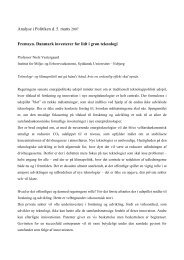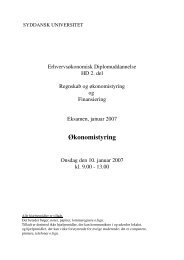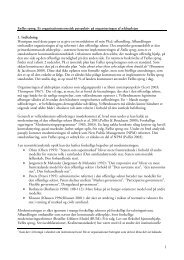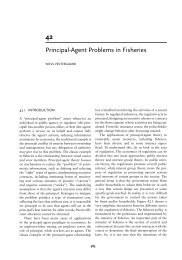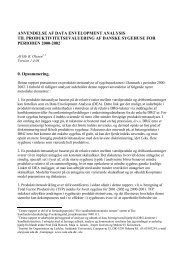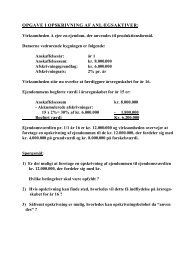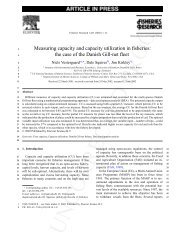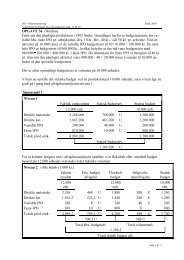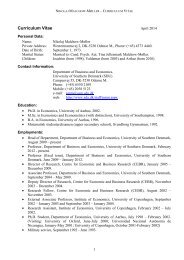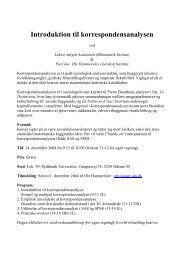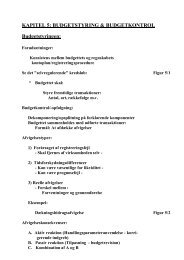Development of Parties and Party Systems in ... - lah@sam.sdu.dk
Development of Parties and Party Systems in ... - lah@sam.sdu.dk
Development of Parties and Party Systems in ... - lah@sam.sdu.dk
- No tags were found...
You also want an ePaper? Increase the reach of your titles
YUMPU automatically turns print PDFs into web optimized ePapers that Google loves.
called “nationalist-patriotic” <strong>and</strong> “fatherl<strong>and</strong>” fronts such as has been the case <strong>in</strong> e.g. Russia<strong>and</strong> Romania.1.9. Coalition build<strong>in</strong>gSeveral election party alliances have merged, <strong>of</strong>ten with the explicit aim to pass the tresholdrequirements stated <strong>in</strong> the lection laws, only rarely the explanation as an approximation on theelitelevel or the policy <strong>and</strong> programme level. As we shall se <strong>in</strong> the cases <strong>of</strong> Solidarity <strong>in</strong> Pol<strong>and</strong><strong>and</strong>the Quadre Coalition (4K) the obstacles for establish<strong>in</strong>g functional party federations became almost<strong>in</strong>surmountable. The ma<strong>in</strong> problem was to create the sufficient loyalty on actor level <strong>and</strong> thenecessary cohesion on the policy <strong>and</strong> programme level. A common “federal” party identity wasalmost impossible to establish. On macro level, the change <strong>of</strong> party identity can be expla<strong>in</strong>ed asmuch by factors <strong>in</strong>ternal to the parties <strong>in</strong>volved <strong>in</strong> the federation as by external factors, i.e. factorsfrom the outside 20 .In several cases only loosely <strong>in</strong>stitutionalized party-alliances <strong>and</strong> umbrella-parties wereestablished. As noticed above, <strong>in</strong> several cases we have been deal<strong>in</strong>g with negative party alliancesthat were focus<strong>in</strong>g on a common enemy such as SDK <strong>in</strong> Slovakia (Meciar), AWS <strong>in</strong> Pol<strong>and</strong> (”postcommunists”)<strong>and</strong> the Four Coalition (4K) <strong>in</strong> the Czech Republic (Klaus <strong>and</strong> Zeman). These partyalliances were not able to obta<strong>in</strong> sufficiently stable <strong>and</strong> def<strong>in</strong>itive party memberships, rather wehave been deal<strong>in</strong>g with ”participants <strong>in</strong> their actions” (Ágh, 1998:103). In general, the cohesion <strong>and</strong>loyalty on the elite level has been low. The movement parties tried to express the ”orig<strong>in</strong>al” <strong>and</strong>”ideal” unity <strong>of</strong> society <strong>and</strong> party. However, they were organizationally fragile, mostly transitorypolitical phenomena, never constitut<strong>in</strong>g functional political parties like we f<strong>in</strong>d them <strong>in</strong> “st<strong>and</strong>ard”competitive multi-party systems. The cult <strong>of</strong> spontaneity <strong>and</strong> the movement l<strong>in</strong>e may overcome thedivision between everyday life <strong>and</strong> politics considered <strong>in</strong> the broader sense, but only <strong>in</strong> the shortterm.Figure : types <strong>of</strong> cooperation <strong>and</strong> alliances among parties <strong>in</strong> the CEESTypes <strong>of</strong> cooperation/alliances Characteristics ExamplesTransitory governmentsNormally formed just after the demise<strong>of</strong> the old system <strong>and</strong> until the firstfree election, <strong>of</strong>ten set up accord<strong>in</strong>g toa compromise between representativesfrom the old <strong>and</strong> new system, i.e. theoppositionNegative party alliancesTactical alliancesCooperation between parties primarilybased on a common enemy, i.e. the(post)communists <strong>and</strong> <strong>in</strong> spite <strong>of</strong>disagreements on both policy <strong>and</strong>actor level<strong>Party</strong> cooperation with the primaryaim to secure the parties <strong>in</strong>volved aThe first non-communist government<strong>in</strong> Pol<strong>and</strong>, the government <strong>in</strong>Czechoslovakia after the velvetrevolution until the first free electionMay-June 1990Election Alliance AWS <strong>and</strong> the AWS-UW government <strong>in</strong> Pol<strong>and</strong>, the SDKledgovernment <strong>in</strong> Slovakia after the1998 election, Democratic Convention<strong>in</strong> Bulgaria, <strong>and</strong> (partly) the 4K <strong>in</strong> theCzech RepublicThe first stage <strong>of</strong> the four partycooperation (4K) <strong>in</strong> the Czech20 John Ishiyama <strong>and</strong> András Bozóki, “Adaption <strong>and</strong> Change:Characteriz<strong>in</strong>g the Survival Strategies <strong>of</strong> the CommunistSuccessor <strong>Parties</strong>, Journal <strong>of</strong> Communist Studies <strong>and</strong> Transition Politics, Vol.17, No.3, September 2001:32-51.27



